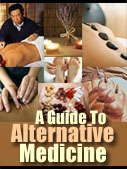Biofeedback
Biofeedback
Biofeedback is a fancy machine used basically the same way a
thermometer or scale is used. When we are sick, we use a thermometer to determine if we have
a fever.
Depending on how high the fever is, we decide how we want to
handle it. (Take over the counter fever reducers or get to the emergency room.)
A thermometer is telling us the biofeedback the information from
our bodies we need to make the decision. It's the same principle with large and more
complicated biofeedback machines.
These machines are used to chart internal functions with more
accuracy than a human alone is capable of, and the results are used to determine and then
gauge how well the treatment is working.
As an example, say you as a biofeedback patient need to learn how
to relax, because you're headed for a stroke. Along with a change in diet and exercise, you
need to learn how to stay calm.
A biofeedback machine hooked up to you in the office, you learn at
what level of stress you start to have physical problems (which are indicated by lights or a
buzzer, what ever the machine does to indicate an off balance of heart rate or stressed -
tightened- muscles.)
The object is for the patient to practice slowing down their heart
rate or relax their muscles until the machines light dims, or buzzer stops going
off.
This is used as a gauge to help patients learn how to listen to
and control their bodies.
The biofeedback therapist teaches the patient exercises and
techniques to use for adjusting the body's rhythm.
In the 1960's laboratory experiments were being conducted to
examine research subject's brain wave activity, blood pressure, and other functions of the
body which are under normal situations are not controlled voluntarily.
The term biofeedback was born.
The outcomes of these experiments was hoped to be increased
creativity at will-by a person being able to change their own brain patterns-or even more
important, the ability to decrease ones own blood pressure, making prescription blood
pressure medication unnecessary.
Although this hope was found to be unrealistic-too many
variables-it has been recorded that biofeedback can help with other conditions such as
chronic pain and stress reduction.
Biofeedback techniques can help with migraines, digestive
disorders, and dangerous rhythms of heartbeat.
The basic treatment involves teaching the patient different forms
of relaxation to adjust the different levels of heart rate and breathing, digesting,
etc.
The gift of biofeedback is that it serves to remind health care
providers and patients that our thoughts and emotions do play a big role in causing and
treating symptoms of illness.
A lot of the outcome depends on the patient. You must adhere to
regimented eating and exercise habits and change your stressful lifestyle in order to achieve
results.
You need to commit to learning and practicing stress relieving
techniques. Relaxation seems to be the key in biofeedback, and although scientists can not
yet determine exactly how it all works, they are able to document that biofeedback does, in
fact, teach patients how to control seemingly involuntary conditions of the nervous and
circulatory systems.
This is thought to be part of the flight or fight reflex system
that we all have, and once had much more strongly, when humans were threatened with physical
harm more than any other.
When we experience stress today, our bodies still react with the
same type of response we did as early man. Our pupils dilate and we start to
sweat.
Our heart rate increases, etc. but because we live in a
"civilized" society now, we can no longer just lash out at seeming threats.
So we hold it in and get sick. The practice of recognizing these
signs and symptoms of stress in our bodies and the ability to control them-thus not becoming
ill-is at the heart of biofeedback.
|























